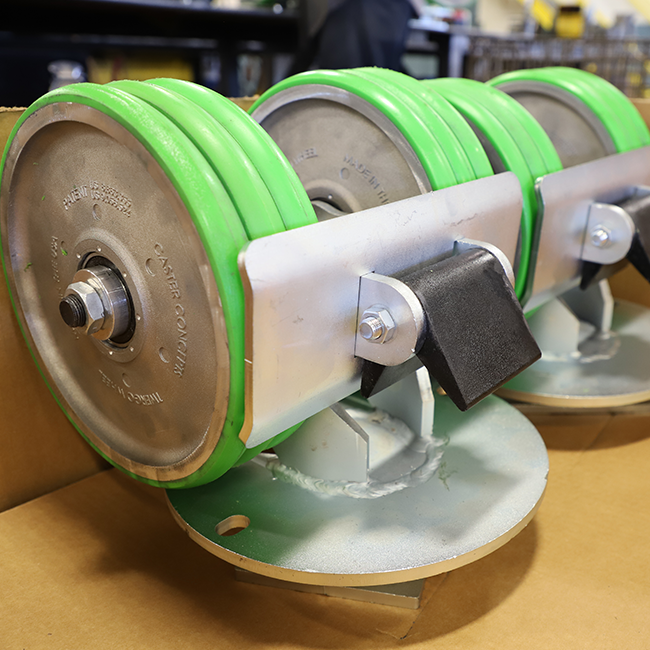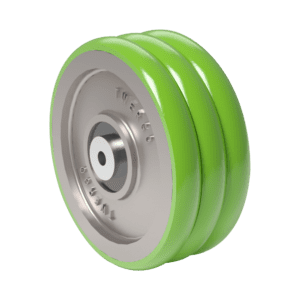

We do get requests like this often. Typically it is because casters are an afterthought when designing a new cart or dolly for a production system. Fortunately, you have a few different caster options to try to improve the push force on your dolly. These options cover the areas of wheel diameter, wheel material, wheel width, wheel design, swivel offset, swivel section construction, and caster placement on the cart.
If there aren’t height constraints, then increasing wheel diameter is the easiest way to reduce the starting force of pushing a heavy cart. Going from a 6’’ diameter wheel to 8’’ diameter wheel can improve (reduce) push forces by 20% on average.
Wheel material is the next variable to consider for easier rollability. A harder wheel material will always have lower push forces – so a steel wheel will roll easier than a urethane treaded wheel. The drawback to a harder wheel is that it can cause wear on concrete or other flooring types. And that leads to other safety and cost issues. The other drawback to harder plastic or urethane wheels – in the 70-80 D durometer range – is that they are more likely to pick up debris, which then negatively impacts the starting push forces.
 These two reasons are why most companies tend to stay with a softer urethane (85-95A durometer) treaded wheel in their facilities. This formulation does not wear the floors and is less likely to pick up debris, which then leads to longer wheel life.
These two reasons are why most companies tend to stay with a softer urethane (85-95A durometer) treaded wheel in their facilities. This formulation does not wear the floors and is less likely to pick up debris, which then leads to longer wheel life.
When evaluating different urethane tires, please note that urethanes with lower compression set and higher rebound will roll easier. However, they typically don’t have the toughness that other comparable urethanes with lower rebounds do. So it is finding the right balance between rollability and toughness for the application.
Wheel width is an interesting variable to consider. The wider the wheel, the easier is is to get the wheel to start rolling. This is because the tire has less of a contact patch length because you are spreading it out over the width. When wheels are exactly the same in diameter and design, except one is wider, the wider wheel will start rolling easier.
The issue comes in when paired into a swivel caster rig. As a wider wheel swivels around during a direction change, the amount of scrubbing increase. And more scrubbing increases your overall push forces. The extra scrubbing results from the inner part of the wheel rotating at a different speed than the outside part of the wheel when the caster is swiveling. This scrubbing can be negated by going to a split wheel design, with multiple independently rotating discs.
 By allowing each section of the wheel to rotate at a different speed, the max push force is reduced when the caster rotates and changes direction. Increasing swivel offset also reduces push force – to a certain point. Swivel offset is how far the center of the wheel is offset from the center of the caster swivel section. The longer the swivel offset, the larger the moment arm, and the easier it is for the caster to swivel around.
By allowing each section of the wheel to rotate at a different speed, the max push force is reduced when the caster rotates and changes direction. Increasing swivel offset also reduces push force – to a certain point. Swivel offset is how far the center of the wheel is offset from the center of the caster swivel section. The longer the swivel offset, the larger the moment arm, and the easier it is for the caster to swivel around.
The detriment to increasing the swivel offset is that it decreases the load capacity of the swivel section. Every caster design has a “sweet spot” for swivel offset, providing the lowest force to swivel the caster while still maintaining the required load capacity.
The typical setup we see in the industry is two swivel casters in the front of the cart and two rigid casters in the rear. This setup works well for most applications. The drawback is when the swivel casters are on same side of the cart, as they can oppose each other while swiveling and spike the starting push force.
You can reduce the impact of this by situating more of the load over to the rigid casters. Sometimes this is easy to accomplish and other times it creates an unstable cart design. A diamond pattern caster layout puts the rigid casters in the center directly underneath the load. This reduces the force added by the swivel casters while swiveling.
The higher the hardness of a swivel section bearing design, the more resistant it is to galling or brinelling. This means the shape of the raceway stays intact and the bearing elements roll easier. The tighter the tolerance, the more the load is spread evenly among the bearing elements. Another way to ensure your caster rolls easier is to maintain a properly lubricated swivel section. This also helps the caster be resistant to corrosion or deterioration from heat build up.
In conclusion, there are many variables to investigate when you have a cart that is not meeting the maximum starting push force allowed by your company. Before you just reduce your cart capacity or spend more money on additional carts, let’s have a conversation to see how we can help maximize productivity and minimize your capital expenses.